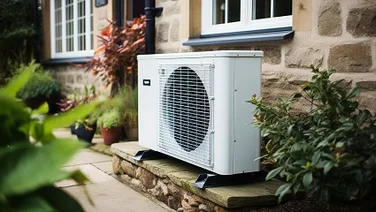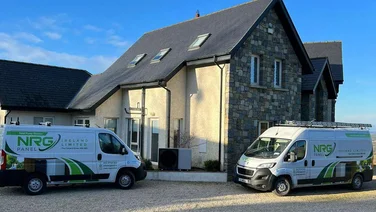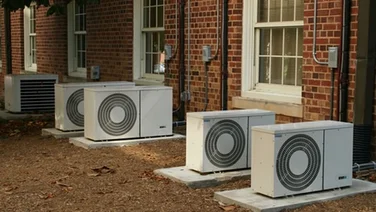- What is a ground source heat pump?
- Pros and cons of a ground source heat pump
- How much does a ground source heat pump cost?
- Heat pump running costs
- Are there any grants for ground source heat pumps?
- How is a ground source heat pump installed?
- Is your property suitable for a ground source heat pump?
- Do you need planning permission for a ground source heat pump?
- What other types of heat pumps are there?
- Next steps
- FAQs
✔ Ground source heat pumps cost between £24,000 and £49,000 to install
✔ You can get a £7,500 discount with the Boiler Upgrade Scheme
✔ Larger properties are best suited for ground source heat pumps
Gas boilers are set to fade from memory, as the UK government starts to limit our reliance on fossil fuel-guzzling heaters and shift to alternatives, leading many to investigate the the costs of ground source heat pumps.
Want to know if your home is suitable for a ground source heat pump? Read on to find out.
We can also help you with comparing prices for heat pumps. Simply enter a few details about your home and our expert installers will get in touch with bespoke quotes for you to compare.

What is a ground source heat pump?
A ground source heat pump is a heating system that uses the ambient warmth of the soil to keep your home warm.
It can be installed either horizontally, which means the pipes used are laid out over a large surface area about a metre under the ground; or vertically, which involves drilling at least one very deep borehole – up to 120 metres.

How does a ground source heat pump work?
Ground source heat pumps absorb the heat from beneath the ground, which is typically a constant 10-12°C in the UK, so you can keep your home warm throughout the year.
The actual unit (which converts the heat from the soil for use in your home) is stored inside, with pipes feeding into it from the outside (either from a vertical or horizontal installation).
The unit heats your home by circulating a refrigerant fluid through the pipes, which absorbs thermal energy from the ground and funnels it back to the heat pump unit inside your property.
A compressor inside the heat pump increases the temperature of the liquid, passing it to a heat exchanger which transfers this heat to your radiators, hot water cylinders, and/or underfloor heating.

How big is a ground source heat pump?
The heat pump unit itself is around the size of a typical boiler, so it won’t take up much space if you’re moving away from a gas boiler.
It’s the space used outside that makes ground source heat pumps much larger systems than other heating methods. You’ll need around 50 square metres of ground per kilowatt capacity of the heat pump. For example, an 8kW heat pump will need 400 square metres of ground.
It takes up much less space for a vertical installation because you just need to be able to drill a borehole, which can be as little as 20 centimetres wide. However, vertical installations are the most expensive type of installation.
Pros and cons of a ground source heat pump
Ground source heat pumps have many advantages over traditional gas boilers, but that doesn’t mean they’re not without their disadvantages.
We’ve also covered how they shape up when compared to air source heat pumps, which use the air to heat your home instead.
Compared to a gas boiler
- Much more energy efficient
- Eligible for grants
- Low carbon heating
- Can increase property value
- Constant, inexhaustible source of heat
- Much longer lifespan than gas boilers
- More expensive to run until electricity prices drop
- Very high installation costs
- Soil type impacts efficiency
- Needs a well-insulated property to work effectively
Compared to an air source heat pump
- Consistent heating output
- Longer lifespan
- Better in regions that regularly drop below 0°C
- Requires a large amount of space
- Much more expensive
- Installation and planning can take weeks, and be disruptive
How much does a ground source heat pump cost?
A horizontally installed ground source heat pump typically costs £24,000 for a three-bedroom home, or £16,500 if you qualify for the Boiler Upgrade Scheme.
Vertical installations cost more because of the complex process of drilling a borehole – expect to pay an average of £49,000.
Both of these cost estimates include the unit, installation, and a hot water tank.
For more information on pricing, our guide to heat pump costs has everything you’ll need.
If you’d rather avoid these high costs, or your home can’t have a ground source heat pump, you can compare air source heat pump prices instead.
Heat pump running costs
A ground source heat pump’s running costs for a three-bedroom household will typically come to around £939 per year.
The average air source heat pump will cost about the same, though this can vary significantly, depending on where you live in the UK.
| Heating method | Efficiency (%) | Annual energy use (kWh) | Cost (p/kWh) | Annual bill |
|---|---|---|---|---|
| Gas boiler | 95 | 11,500 | 6.04 | £694 |
| Heat pump | 300 | 3,833 | 24.50 | £939 |
| Oil boiler | 92 | 11,875 | 11.14 | £1,337 |
| Electric boiler | 100 | 10,925 | 24.50 | £2,676 |
Are there any grants for ground source heat pumps?
The main grant available for ground source heat pumps is the Boiler Upgrade Scheme (BUS), which will run until March 2028. It provides discounts of £7,500 for a ground source heat pumps and all you need to do is contact a supplier – the scheme will arrange the discount on your behalf.
Just 90,000 homes will benefit from the BUS, and the government has been criticised for the slow rollout after falling short of their target by about 67%.
Alternatively, there’s the government’s Energy Company Obligation scheme, which is in its fourth and final stage (ECO4). ECO4 gives funding towards ground source heat pumps for homes with Energy Performance Certificate (EPC) ratings of G, F, or E.
It won’t fully cover the cost of a ground source heat pump, but it will provide some funding to make one easier to purchase.
If you live in Wales, you could qualify for the Nest scheme, which assesses whether a home needs improvements. These improvements can include funding for a ground source heat pump, so it’s well worth checking to see if you qualify.
Read our guide on government grants for heat pumps for more information.
How is a ground source heat pump installed?
A ground source heat pump is installed differently depending on whether it’s a vertical or horizontal installation:
Vertical installation – vertical ground source heat pumps require a borehole to be dug many feet below the ground. Depths can be anywhere between 15 and 120 metres. It can be even deeper in some circumstances, such as in busy urban areas where underground space is at a premium (existing pipes, for example).
The heat at these depths is more consistent than in horizontal installations, so you’ll get a considerably higher heat collection efficiency.
However, vertical installations are typically more expensive and are not suitable for properties as a borehole cannot be dug. Sometimes, the geology on a property just isn’t compatible with a borehole, such as soft clay that could cause the borehole to collapse.
Horizontal installation – horizontal installations are done by digging a system of trenches one to two metres deep. Polyethylene pipes are installed in these trenches and then covered again. A refrigerant liquid is then pumped through these pipes to absorb the ambient warmth of the soil.
How long does a ground source heat pump installation take?
A professional ground source heat pump installer will take between one and two days for a horizontal installation, and five days or more for a vertical installation. This is because of the difference in complexity and the logistical challenges of installing pipework many metres below ground.
According to the heat pump manufacturer Kensa, you can hire a machine to dig the trenches before a professional carries out the technical installation, but this isn’t recommended.
lt’ll likely take longer and there’s a chance you’ll make a mistake that could lead to the heat pump not working properly.
We’ll always recommend hiring a professional to install your ground source heat pump for this reason.
Is your property suitable for a ground source heat pump?
To work out if your property if suitable for a ground source heat pump, consider the following:
How much space your property has – A typical horizontal ground source heat pump will require 50m² of ground per kilowatt of power.
Vertical installations only need space for the drilling rig because the borehole is usually no longer than 25cm across. However, the drilling equipment can be challenging to get into your garden in built-up areas.
Your home’s insulation level – Ground source heat pumps – and heat pumps in general – work best when a property already has a high level of insulation.
Qualifying for the BUS, for example, requires that a property has an EPC that states the building “has no recommendations for loft or cavity wall insulation.”
If you don’t have good insulation, it’s best to start with improving it first. This is because the lower your insulation, the higher your home’s heat demand is, and this requires a more powerful system, which’ll be more expensive.
The kind of heating system your home uses – Your home’s radiators or underfloor heating system – or both –, will have an impact on suitability for ground source heat pumps.
If your radiators are too small, then you’ll struggle to heat your home efficiently. This means you’ll need to upgrade their size before getting a ground source heat pump installed.Underfloor heating is ideally suited for ground source heat pumps because heat pumps work at a lower temperature.
Underfloor heating works best at lower temperatures as it’s typically left on for longer than radiators and covers a larger surface area.
Do you need planning permission for a ground source heat pump?
Ground source heat pumps are listed as permitted developments, meaning you won’t need to apply for planning permission in the majority of situations.
However, if you live in a listed building or conservation area, you should contact your council to find out local requirements.
This is because ground source heat pumps, particularly horizontal installations, are quite disruptive to the ground. Some properties reside in Areas of Outstanding Natural Beauty (AONB), and the AONB can occasionally fall within the garden limits.
What other types of heat pumps are there?
The two main alternatives to ground source heat pumps are air source heat pumps, and water source heat pumps.
Air source heat pumps use the ambient warmth in the outside air to warm your home – they can even work in temperatures as low as -10°C. Some models are built to keep warming your home when it drops to -25°C but once the temperature gets this low, air source heat pumps start to struggle.
Water source heat pumps keep you warm by extracting the warmth in a body of water, usually a lake or river. They use a series of pipes filled with anti-freeze liquid which gathers ambient warmth from the water, sending it through the heat pump unit to warm your home.
Next steps
Ground source heat pumps are excellent tools to heat your home without burning fossil fuels. They’re much more expensive than traditional boilers, so it’s difficult to recommend ground source heat pumps from a financial point of view.
It is easy to recommend them for their environmental benefits though. This is because ground source heat pumps only require electricity to run. If reducing your carbon emissions is important to you, heat pumps are an eco-friendly way to warm your home.
You can always compare prices for air source heat pumps if ground source heat pumps aren’t ideal for your home or budget. We’ll put you in touch with our expert installers, who’ll get back to you with obligation-free quotes for you to compare.
FAQs
Are ground source heat pumps any good?
Ground source heat pumps are incredibly efficient, with an output that is three to four times the amount of energy that goes in, which is an efficiency rating between 300–400%. Even the most efficient gas boilers can never go over 100% efficiency.
You also get year-round heating consistency because ground source heat pumps use the ambient temperature of the soil. The warmth in the soil remains constant throughout the year, making ground source heat pumps highly effective in the winter.
What are common problems with ground source heat pumps?
Ground source heat pumps rarely run into problems because they’re stable units designed to last. However, sometimes issues arise with the refrigerant liquid that stops the system from absorbing heat from the soil efficiently.
When this happens, you might need to get the liquid replaced. This usually involves flushing the system and replacing the liquid without needing to dig up the pipework.
The most common problems are those that happen to the unit stored inside your home, such as an issue with the heat exchanger. If the heat exchanger stops working optimally, you won’t be able to warm your home as effectively.
In most cases, you’ll need to hire a professional to fix any problems because heat pumps are expensive pieces of equipment and it can be risky trying to solve the issues yourself.
Can any house have a ground source heat pump?
Ground source heat pumps are best suited to properties with either enough space for a horizontal installation or the capability to drill a borehole. A high level of insulation is needed too – otherwise a home can lose too much heat and a ground source heat pump becomes unable to warm it successfully.
Are ground source heat pumps worth the cost?
If your motivation for getting a ground source heat pump is to save money, we wouldn’t recommend one. You’ll spend anywhere from £24,000 to £49,000 on a ground source heat pump, depending on whether it’s a horizontal or vertical installation.
Even with the £7,500 grant from the Boiler Upgrade Scheme, you won’t break even on a ground source heat pump for decades.
What a ground source heat pump will do is drastically reduce your carbon footprint, as gas boilers are one of the biggest sources of a household’s carbon emissions.







